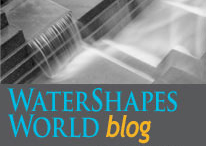ARTICLES
Advance Search
Aquatic Health
Aquatic Health, Fitness & Safety
Around the Internet
Aquatic Culture
Aquatic Technology
Artful Endeavors
Celebrity Corner
Life Aquatic
Must-See Watershapes
People with Cameras
Watershapes in the Headlines
Art/Architectural History
Book & Media Reviews
Commentaries, Interviews & Profiles
Concrete Science
Environment
Fountains
Geotechnical
Join the Dialogue
Landscape, Plants, Hardscape & Decks
Lighter Side
Ripples
Test Your Knowledge
The Aquatic Quiz
Other Waterfeatures (from birdbaths to lakes)
Outdoor Living, Fire Features, Amenities & Lighting
Plants
Ponds, Streams & Waterfalls
Pools & Spas
Professional Watershaping
Structures (Editor's Notes)
Travelogues & History
Water Chemistry
WaterShapes TV
WaterShapes World Blog
Web Links
Around the Internet
Aquatic Culture
Aquatic Technology
Artful Endeavors
Celebrity Corner
Life Aquatic
Must-See Watershapes
People with Cameras
Watershapes in the Headlines
Humans have been inventing ways to control water since the dawn of recorded history and almost certainly long before that. Among the most significant ancient hydraulic achievements, many have emerged from Greece where technologies such as the water wheel, positive displacement pumps, and the world's oldest operating fountain were all devised.
Managing waste water in the form of run-off and especially filter-backwash effluent can be surprisingly problematic, observes Dave Peterson, especially when the issue is left to an afterthought. In this detail, he offers an elegant waste-water solution in the form of a simple backwash pit.
At their best, watershape designs make artistic statements that compliment and amplify the surrounding environment, while reflecting the personality of both the designer and homeowner. As Eric Herman relates, it's a feeling that's hard to define, but yet unmistakable when present.
Producing Watershape University's online courses may seem relatively simple and straightforward, but according to Brett Herman, WU's director of digital engagement, there are many moving pieces and technologies that must be coordinated and smoothly implemented to bring presentations to fruition.
The presence of unwanted cold water can lead to call-backs for builders and technicians who install heaters improperly. That's not good, notes Mike Fowler, who writes that keeping customers warm and happy requires following these sizing, selection, installation and maintenance procedures.
Sharing time in a pool has a way of carrying everyone involved to a relaxed state of mind that lets the rigors of daily life temporarily slip away. It's a sensation Eric Herman recently experienced with a group of friends, all of whom lead energetic, stressful lives.
Engineers carry an almost sacred trust, with watershapers relying on them to design structures and systems that are reliable, science-based and code-compliant. When that trust is broken, says Dave Peterson and Bill Drakeley, the consumer's investment is at risk -- as is the watershaper's reputation.
Designing fountain features requires understanding the needs of the space, the clients and how the technology meets those demands. The Atlantic Station Park Expansion Project in Atlanta is a classic example of that kind of design adaptation - especially considering the engineering methodology needed to bring complex water displays to life. When our company, Fountain Source, Sierra Madre, Calif., became involved, the property was
While many construction details are forever hidden from view, notes Dave Peterson, others stand front and center. This waterwall treatment, for instance, is a prime example of a simple design idea that shapes the fluid characteristics of the feature while also keeping it from splashing into the surrounding area.




















